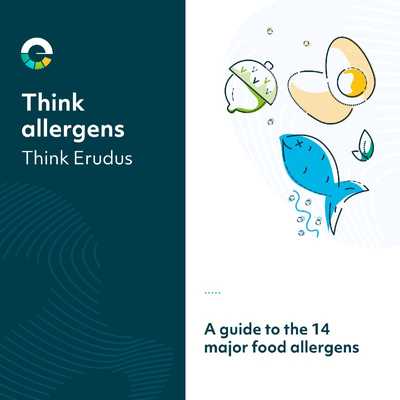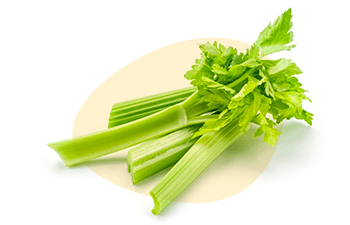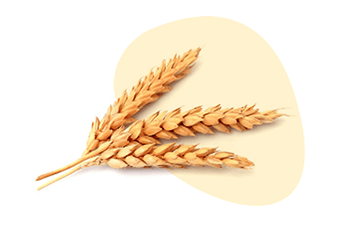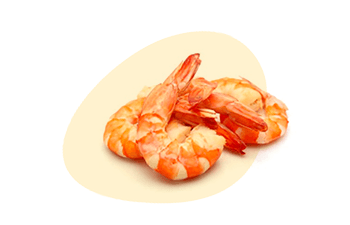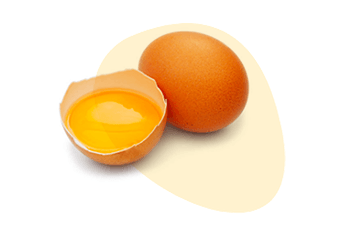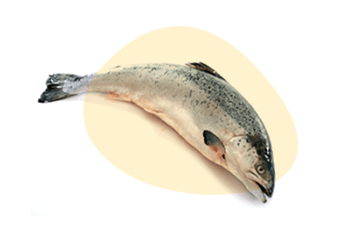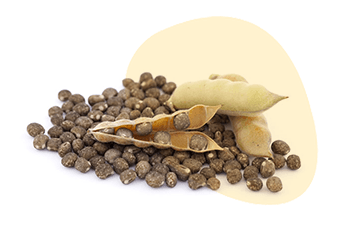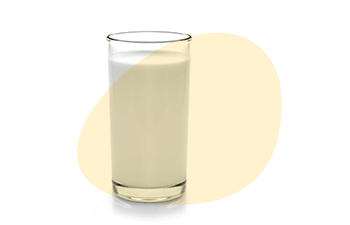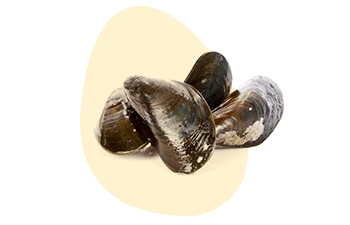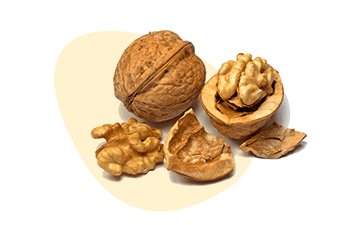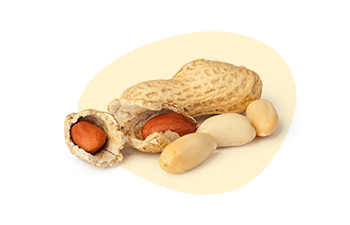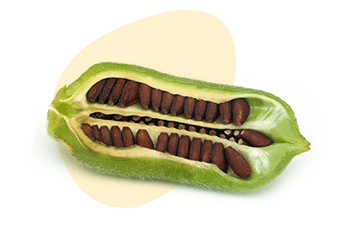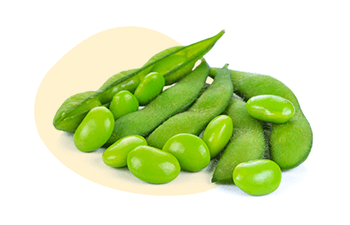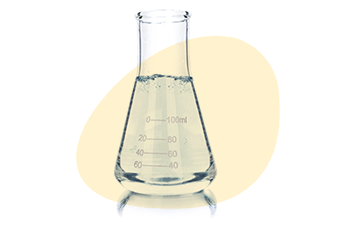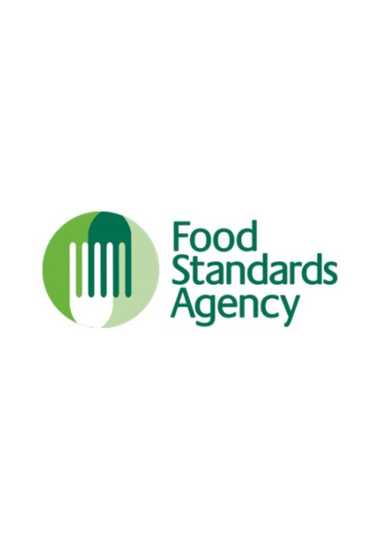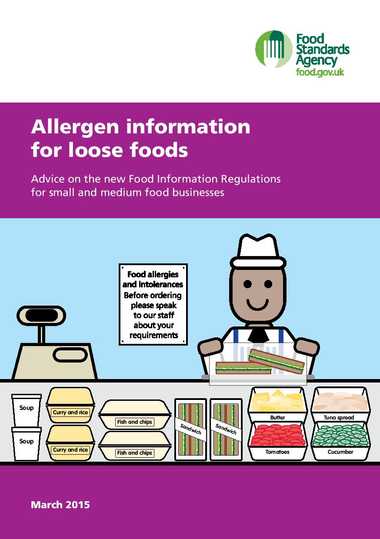What are the 14 major food allergens?
The EU legislation, EU Food Information Regulation (FIR) and Food Information for Consumers Regulation No. 1169/2011 (FIC) came into force on the 13th December 2014 impacting all Caterers, food Retailers, Wholesalers and foodservice companies.
Caterers and food businesses are required by law to be able to provide customers with accurate information on the EU’s 14 major food allergens if they are included in any of the food products they produce, sell or serve.
You’ll find a list of the 14 major food allergens below.
THE 14 MAJOR FOOD ALLERGENS
What to look for on the label and common foods containing the allergen
Celery
This includes celery stalks, leaves, seeds and the root. Celery is usually found in celery salt, salads, some meat products, soups and stock cubes.
What to look for on the label
Celariac or Celeriac, Celery leaf, Celery salt, Celery seed, Celery stalk
Common foods containing celery
Bouillon, curry, Marmite, prepared salads, processed meat products, sausages, savoury snacks, spice mixes, soups, vegetable juice
Surprising foods containing celery
Batter for frozen foods, cured bacon (celery juice is sometimes used in its preparation), flavoured crisps, marmite, ready meals, sandwiches that have been pre-prepared, spice mixes, stock cubes
Symptoms of a celery allergy
Abdominal pain, diarrhoea, difficulty swallowing, dizziness, face and/or throat swelling, hives, mouth itching or tingling, red, itchy rash (either raised or not raised), shortness of breath and/or wheezing, sneezing, wheezing, vomiting and nausea.
An allergic reaction may also result in anaphylaxis, which can be fatal. Symptoms include collapsing and losing consciousness, difficulty breathing, faintness and dizziness, swollen tongue and issues with speaking or swallowing.
Alternatives to celery
Bok choi, cucumber, fennel, jicama
Find out more about a Celery allergy in our Allergen Deep Dive: Celery.
Cereals Containing Gluten
Wheat, rye, barley and oats are often found in foods containing flour, some baking powder, batter, breadcrumbs, cakes, couscous, meat products, pasta, pastry, sauces, soups and some fried food.
What to look for on the label
Barley, Couscous, durum Wheat, Einkorn, Faro, Kamut, Malt, Oat, Rye, Semolina, Spelt, Wheat
Common foods containing cereals
Baked goods, baking mixes, bread, cereals, chocolate, condiments, crackers, pasta, pastry, sauces
Surprising foods containing cereals containing gluten
Bouillon cubes, broths and stocks, certain blue/veined cheeses, chewing gum, chips and fries, ground spices, lagers, stouts and IPAs, mayonnaise, mustard, ready-made pasta sauces, roasted nuts, salad dressings, salt and vinegar crisps, vodka
Symptoms of a cereals containing gluten allergy
Abdominal pain, diarrhoea, difficulty swallowing, dizziness, face and/or throat swelling, hives, mouth itching or tingling, red, itchy rash (either raised or not raised), shortness of breath and/or wheezing, sneezing, wheezing, vomiting and nausea.
An allergic reaction may also result in anaphylaxis, which can be fatal. Symptoms include collapsing and losing consciousness, difficulty breathing, faintness and dizziness, swollen tongue and issues with speaking or swallowing.
Alternatives for cereals containing gluten
Chia seeds, coconut flour, corn flour, flax flour, millet, quinoa, rice, rice flour, xanthan gum
Find out more about a Cereals Containing Gluten allergy in our Allergen Deep Dive: Cereals Containing Gluten.
Crustaceans
Crabs, lobster, prawns and scampi are crustaceans. Shrimp paste is an allergen in this category that is commonly used in Thai and Southeast Asian cooking.
What to look for on the label
Amphipods, Barnacles, Crabs, Crayfish, Hermit Crabs, Isopods, Lobsters, Mantis Shrimp, Mussel Shrimp, Mysids, Prawns, Sea Spiders, Shrimp
Common foods containing crustaceans
Asian salads, Chinese products, fish paste, fish soup, fried rice, paella, prepared sauces, soups, Thai curry
Surprising foods containing crustaceans
Bouillabaisse, fish stock, nutritional supplements
Symptoms of a crustaceans allergy
Abdominal pain, diarrhoea, difficulty swallowing, dizziness, face and/or throat swelling, hives, mouth itching or tingling, red, itchy rash (either raised or not raised), shortness of breath and/or wheezing, sneezing, wheezing, vomiting and nausea.
An allergic reaction may also result in anaphylaxis, which can be fatal. Symptoms include collapsing and losing consciousness, difficulty breathing, faintness and dizziness, swollen tongue and issues with speaking or swallowing.
Alternatives to crustaceans
Kosher Surimi, monkfish, mushrooms
Find out more about a Crustacean allergy in our Allergen Deep Dive: Crustaceans.
Eggs
Eggs are found in cakes, some meat products, mayonnaise, mousses, pasta, quiche, sauces and pastries. Some food products are glazed with eggs during or before cooking.
What to look for on the label
Albumin, Apovitellin, Cholesterol free egg substitute, Dried egg solids, Dried egg, Egg, Egg wash, Egg white, Egg yolk, Eggnog, Fat substitutes, Globulin, Livetin, Lysozyme, Mayonnaise, Meringue, Meringue powder, Ovalbumin, Ovoglobulin, Ovomucin, Ovomucoid, Ovotransferrin, Ovovitelia, Ovovitellin, Powdered eggs, Silici albuminate, Simplesse, Surimi, Trailblazer, Vitellin, Whole egg
Common foods containing eggs
Artificial flavourings, baked goods, cakes, custard, egg-glazed pastry, hollandaise, ice cream, mayonnaise, marshmallow, marzipan, meringue, lecithin, natural flavourings, nougat, pasta, salad dressing, tartare sauce
Surprising foods containing eggs
Artificial crab meat (Surimi), artificial flavourings, bagels, baked pretzels, fresh pasta, lollipops, marshmallows, pies, protein shakes, wine
Symptoms of a egg allergy
Abdominal pain, diarrhoea, difficulty swallowing, dizziness, face and/or throat swelling, hives, mouth itching or tingling, red, itchy rash (either raised or not raised), shortness of breath and/or wheezing, sneezing, wheezing, vomiting and nausea.
An allergic reaction may also result in anaphylaxis, which can be fatal. Symptoms include collapsing and losing consciousness, difficulty breathing, faintness and dizziness, swollen tongue and issues with speaking or swallowing.
Alternatives to eggs
Applesauce, Ener-G egg replacer, ground flaxseeds and water, Loprofin egg replacer, Loprofin egg white replacer, mashed banana, No-egg replacer, nut butters, silken tofu
Find out more about a Eggs allergy in our Allergen Deep Dive: Eggs.
Fish
You may find fish sauces in pizzas, relishes, salad dressings, stock cubes and Worcestershire sauce.
What to look for on the label
Anchovies, Bass, Catfish, Cod, Flounder, Grouper, Haddock, Hake, Halibut, Herring, Mahi Mahi, Perch, Pike, Pollock, Salmon, Scrod, Snapper, Sole, Swordfish, Tilapia, Trout, Tuna
Common foods containing fish
Bouillabaisse, Caesar salad and Caesar dressing, caponata - a Sicilian eggplant/aubergine relish, gelatine, dips, imitation or artificial fish or shellfish (“sea legs” or “sea sticks” is one example), meatloaf, nam pla (fish sauce), pizza, relishes, soups
Surprising foods containing fish
Barbecue sauce, tomato sauce, Worcestershire sauce
Symptoms of a fish allergy
Abdominal pain, diarrhoea, difficulty swallowing, dizziness, face and/or throat swelling, hives, mouth itching or tingling, red, itchy rash (either raised or not raised), shortness of breath and/or wheezing, sneezing, wheezing, vomiting and nausea.
An allergic reaction may also result in anaphylaxis, which can be fatal. Symptoms include collapsing and losing consciousness, difficulty breathing, faintness and dizziness, swollen tongue and issues with speaking or swallowing.
Alternatives to fish
Crabs, dried mushrooms, dried seaweed, jackfruit, prawns, seaweed, seitan, tofu, vegan fish
Find out more about a Fish allergy in our Allergen Deep Dive: Fish.
Lupin
Lupin is a flower, but it is also sometimes found in flour and sometimes used in bread, pastries and pasta.
What to look for on the label
Lupine, Lupin bean, Lupin flour, Lupin seed
Common foods containing lupin
Crepes, deep-coated or fried vegetables such as onion rings, pancakes, pastry cases, pies, pizzas, products containing crumb, vegetarian meat substitutes, waffles
Surprising foods containing lupin
Animal-free milk, chicken bouillon, chicken soup, cookies
Symptoms of a lupin allergy
Abdominal pain, diarrhoea, difficulty swallowing, dizziness, face and/or throat swelling, hives, mouth itching or tingling, red, itchy rash (either raised or not raised), shortness of breath and/or wheezing, sneezing, wheezing, vomiting and nausea.
An allergic reaction may also result in anaphylaxis, which can be fatal. Symptoms include collapsing and losing consciousness, difficulty breathing, faintness and dizziness, swollen tongue and issues with speaking or swallowing.
Alternatives to lupin
Chickpeas, chickpea flour, coconut flour, corn flour, peanuts, peanut flour, rice flour, wheat flour
Find out more about a Lupin allergy in our Allergen Deep Dive: Lupin.
Milk
Milk is found in dairy products such as butter, cheese, cream, milk powders and yoghurt. Some foods are also glazed with milk during or before cooking. Milk is also commonly found in powdered soups and sauces.
What to look for on the label
Milk — 1% Milk, 2% Milk, acidophilus Milk, buttermilk, buttermilk blend, buttermilk solids, cultured Milk, condensed Milk, dried Milk, dry Milk solids (DMS), evaporated Milk, fat-free Milk, full cream Milk powder, goat’s Milk, lactose-free Milk, low-fat Milk, malted Milk, Milk derivative, Milk powder, Milk protein, Milk solids, Milk solid pastes, nonfat dry Milk, nonfat Milk, nonfat Milk solids, pasteurised Milk, powdered Milk, sheep’s Milk, skim milk, skimmed Milk, skim Milk powder, sour Milk, sour Milk solids, sweet cream buttermilk powder, sweetened condensed Milk, sweetened condensed skim Milk, whole Milk
Butter - Artificial butter, artificial Butter flavour, Butter, Butter extract, Butter fat, Butter flavoured oil, Butter solids, dairy Butter, natural Butter, natural Butter flavour, whipped Butter
Caseinates — Ammonium caseinate, Calcium caseinate, Casein, Hydrolyzed casein, Iron caseinate magnesium caseinate, Potassium caseinate, Sodium caseinate, Zinc caseinate
Cheese — Cheese (all types), Cheese flavour (artificial and natural), Cheese food, imitation Cheese, vegetarian Cheese with casein
Cream - Clotted cream, Cream, Double cream, imitation Sour cream, Single cream, Sour cream, Sour cream solids, Whipped cream
Dairy products - Curds, Custard, Dairy product solids, Galactose, Ghee, Hydrolysates — Casein hydrolysate, Milk protein hydrolysate, Protein hydrolysate, Whey hydrolysate, Whey protein hydrolysate Ice cream, Ice milk, Sherbet, Casein, Whey, Lactalbumin, Lactulose, Lactoferrin, Lactoglobulin, Milk protein, Hydrolysate, Lactalbumin, Lactalbumin phosphate, Lactate solids, Lactic yeast, Lactitol monohydrate, Lactoglobulin, Lactose, Lactulose, Milk fat, anhydrous milk fat, Nisin preparation, Nougat, Pudding, Quark, Recaldent, Rennet, Rennet casein, Simplesse® (fat replacer), Whey — acid whey, Cured whey, Delactosed whey, Demineralised whey, Hydrolyzed whey, Powdered whey, Reduced mineral whey, Sweet dairy whey, Whey, Whey protein, Whey protein concentrate, Whey powder, Whey solids, Yogurt (regular or frozen), Yogurt powder
Common foods containing milk
Butter, buttermilk, caramel flavouring, cream, cheese, chocolate, custard, flavouring, ghee, high-protein flour, ice cream, instant mash, lactic acid starter culture, milk, milk powder, natural flavouring, rice cheese, soy cheese, yoghurt
Surprising foods containing milk
Canned tuna, chewing gum, flavoured crisps, hot dogs, margarine, pâté, steak
Symptoms of a milk allergy
AAbdominal pain, diarrhoea, difficulty swallowing, dizziness, face and/or throat swelling, hives, mouth itching or tingling, red, itchy rash (either raised or not raised), shortness of breath and/or wheezing, sneezing, wheezing, vomiting and nausea.
An allergic reaction may also result in anaphylaxis, which can be fatal. Symptoms include collapsing and losing consciousness, difficulty breathing, faintness and dizziness, swollen tongue and issues with speaking or swallowing.
Alternatives to milk
Almond milk, coconut milk, hemp milk, rice milk, soy milk, vegan butter, vegan cheese
Find out more about a Milk allergy in our Allergen Deep Dive: Milk.
Molluscs
Molluscs include mussels, land snails, squid and whelks, and can also be found in oyster sauce - which is commonly used in fish stews.
What to look for on the label
Abalone, Clams and cockles, Mussels, Mussels, Octopus, Oysters, Scallops, Snails, Squid
Common foods containing molluscs
Calamari, ethnic or international food, L’escargot, mussel dishes, scallops, soups, sauces, stews
Surprising foods containing molluscs
Black risotto, fish stock, stout (beer)
Symptoms of a molluscs allergy
Abdominal pain, diarrhoea, difficulty swallowing, dizziness, face and/or throat swelling, hives, mouth itching or tingling, red, itchy rash (either raised or not raised), shortness of breath and/or wheezing, sneezing, wheezing, vomiting and nausea.
An allergic reaction may also result in anaphylaxis, which can be fatal. Symptoms include collapsing and losing consciousness, difficulty breathing, faintness and dizziness, swollen tongue and issues with speaking or swallowing.
Alternatives to molluscs
Fish sauce, pureed mushroom, teriyaki, Worcestershire sauce
Find out more about a Mollusc allergy in our Allergen Deep Dive: Molluscs.
Mustard
This includes Mustard in the form of powder, liquid and seeds. This ingredient is used in breads, curry, marinades, meat products, salad dressings, sauces and soups.
What to look for on the label
Mustard, Mustard flour, Mustard leaves, Mustard oil, Mustard powder, Mustard seeds, sprouted Mustard seeds
Common foods containing mustard
Barbecue Sauce, béarnaise sauce, chutney, Cumberland Sauce, curry sauce, dehydrated soups, flavouring or seasonings, gravies, Indian foods, ketchup or tomato sauce, marinades, mayonnaise, pesto, piccalilli, pickled products, salad dressings (including vinaigrettes and cruditées), sauces, sausages and processed meat products, soups, spices, vegetables with vinegar
Surprising foods containing mustard
Fish paste, hamburger patties, pizza, processed meat, salad cream
Symptoms of a mustard allergy
Abdominal pain, diarrhoea, difficulty swallowing, dizziness, face and/or throat swelling, hives, mouth itching or tingling, red, itchy rash (either raised or not raised), shortness of breath and/or wheezing, sneezing, wheezing, vomiting and nausea.
An allergic reaction may also result in anaphylaxis, which can be fatal. Symptoms include collapsing and losing consciousness, difficulty breathing, faintness and dizziness, swollen tongue and issues with speaking or swallowing.
Alternatives to mustard
Caraway seeds, horseradish, turmeric, wasabi
Find out more about a Mustard allergy in our Allergen Deep Dive: Mustard.
Nuts (Tree nuts)
Nuts (excluding Peanuts) refers to nuts that are grown on trees; unlike peanuts, which are grown underground. This includes cashew nuts, almonds and hazelnuts.
Read our guide to the different types of (Tree) Nuts here.
What to look for on the label
Almond, Almonds, Brazil Nuts, Cashew, Cashews, Hazelnuts, Pecan Nuts, Macadamia or Queensland Nuts, Pistachio Nuts, Walnuts
Detailed List: –
Almond, Almond paste, Anacardium nuts, Anacardium occidentale (Anacardiaceae) [botanical name, Cashew], Bertholletia excelsa (Lecythidaceae) [botanical name, Brazil nut], Carya illinoensis (Juglandaceae) [botanical name, Pecan], Cashew, Castanea pumila (Fagaceae) [botanical name, Chinquapin], Hazelnut, Juglans spp. (Juglandaceae) [botanical name, Walnut, Butternut, Heartnut] Karite (shea nut), Lichee nut, Litchi chinensis Sonn. Sapindaceae [botanical name, Lichee nut] Lychee nut, Macadamia nut, Macadamia spp. (Proteaceae) [botanical name, Macadamia nut/Bush nut], Mandelonas, Marzipan, Mashuga nuts, Nangai nuts, Natural nut extract (for example, almond extract), Nougat, Nu-Nuts®, Nut butters (e.g., Almond butter, Hazelnut butter, Brazil nut butter, Macadamia nut butter, Pistachio nut butter, Shea nut butter, Karike butter, as well as other nut butters), Nut meal, Nutella ®, Nutmeat, Nut oil (e.g., Walnut oil as well as other nut oils), Nut paste, Nut pieces, Pecan, Pigñolia, Pili nut, Pine nut, Pine nut (Indian, piñon, pinyon, pigndi, pigñolia, pignon nuts), Pinon nut, Piñon or Piñon nut, Pinus spp. (Pineaceae) [botanical name, Pine nut/piñon nut], Pistachio, Pistacia vera L. (Anacardiaceae) [botanical name, Pistachio], Pralines, Prunus dulcis (Rosaceae) [bontanical name, almond] Shea nut, Sheanut, Vitellaria paradoxa C.F. Gaertn. (Sapotaceae) [botanical name, Shea nut] Walnut (English, Persian, Black, Japanese, California)
Common foods containing nuts
Artificial flavourings, baked goods, barbecue sauce, chocolate spread, chocolates, crackers, desserts, mortadella, natural flavourings, nougat, pesto, salad dressings
Surprising foods containing nuts
Brown ale, curry paste, energy bars, flavoured and speciality coffee, frozen puddings and desserts, gin, ice-cream, pad thai, veggie burgers, vegan cheese, vodka
Symptoms of a nuts allergy
Abdominal pain, diarrhoea, difficulty swallowing, dizziness, face and/or throat swelling, hives, mouth itching or tingling, red, itchy rash (either raised or not raised), shortness of breath and/or wheezing, sneezing, wheezing, vomiting and nausea.
An allergic reaction may also result in anaphylaxis, which can be fatal. Symptoms include collapsing and losing consciousness, difficulty breathing, faintness and dizziness, swollen tongue and issues with speaking or swallowing.
Alternatives to nuts
Chickpeas, chia seeds, flax seeds, pumpkin seeds, sesame seeds, soy beans, toasted oats, tiger nuts
Find out more about a Nut allergy in our Allergen Deep Dive: (Tree) Nuts.
Peanuts
Peanuts are often used as an ingredient in biscuits, cakes, curries, desserts, sauces, groundnut oil and peanut flour.
What to look for on the label
Arachis oil, Arachis oil, Arachis, Arachis hypogaea, Artificial nuts, Beer nuts, Boiled Peanuts, Cold pressed Peanut oil, Crushed nuts, Crushed Peanuts, Earth nuts, Extruded or expelled Peanut oil, Goober peas, Ground nuts, Ground Peanuts, Hydrolyzed Peanut protein, Kernels, Mandelonas, Mixed nuts, Monkey nuts, Nut pieces, Nutmeat, Peanut butter, Peanut butter chips, Peanut butter morsels, Peanut flour, Peanut paste, Peanut protein, Peanut sauce, Peanut syrup, Virginia Peanuts
Common foods containing peanuts
Artificial flavouring, baked goods, candy, chocolate, crumb toppings, egg rolls, enchiladas, ethnic and international foods: African, Asian, Chinese, Indian, Indonesian, Mexican, Thai, Vietnamese, fried foods, hydrolyzed plant protein, hydrolyzed vegetable protein, marzipan, mole sauce, natural flavouring, nougat
Surprising foods containing peanuts
Chilli, crackers, curry sauce and paste, energy bars, flavoured and speciality coffee, frozen puddings and desserts, ice cream, Indian food, salad dressing, sauces, soup, veggie burgers
Symptoms of a peanuts allergy
Abdominal pain, diarrhoea, difficulty swallowing, dizziness, face and/or throat swelling, hives, mouth itching or tingling, red, itchy rash (either raised or not raised), shortness of breath and/or wheezing, sneezing, wheezing, vomiting and nausea.
An allergic reaction may also result in anaphylaxis, which can be fatal. Symptoms include collapsing and losing consciousness, difficulty breathing, faintness and dizziness, swollen tongue and issues with speaking or swallowing.
Alternatives to peanuts
Cashew nuts, tahini, tiger nuts
Find out more about a Peanuts allergy in our Allergen Deep Dive: Peanuts.
Sesame
Sesame seeds are found commonly in bread, usually sprinkled on buns such as hamburger buns, bread sticks, and are also used to make hummus, sesame oil and tahini.
What to look for on the label
Benne, Benne seed, Gingelly, Gingelly oil, Sesame oil, Sesame seeds
Common foods containing sesame
Bagels, bread, butter, chutney, crackers, dressings, dips, hummus, marinades, sauces, soups, tahini, toast
Surprising foods containing sesame
Baba ganoush, cereal, margarine, melba toast, noodles, pretzels, processed meats, rice cakes, risotto, salads, shish kebabs, stews, stir fry, vegetarian burgers, sushi
Symptoms of a sesame allergy
Abdominal pain, diarrhoea, difficulty swallowing, dizziness, face and/or throat swelling, hives, mouth itching or tingling, red, itchy rash (either raised or not raised), shortness of breath and/or wheezing, sneezing, wheezing, vomiting and nausea.
An allergic reaction may also result in anaphylaxis, which can be fatal. Symptoms include collapsing and losing consciousness, difficulty breathing, faintness and dizziness, swollen tongue and issues with speaking or swallowing.
Alternatives to sesame
Almonds, avocado oil, cashew nuts, chia seeds, olive oil, peanut oil, perilla, poppy seeds, pumpkin seeds, sunflower seeds
Find out more about a Sesame allergy in our Allergen Deep Dive: Sesame.
Soya
Soya is found in bean curd, edamame beans, miso pates, textured soya protein, soya flour or tofu, and is a staple ingredient in oriental food. It can also be found in desserts, ice cream, meat products, sauces and vegetarian products.
What to look for on the label
Bean curd, Edamame (soybeans in pods), Hydrolyzed soy protein, Kinnoko flour, Kyodofu (freeze dried tofu), Miso, Natto, Okara (soy pulp), Shoyu sauce, Soy albumin, Soy concentrate, Soy fibre, Soy formula, Soy grits, Soy flour, Soy lecithin, Soy milk, Soy miso, Soy nuts, Soy nut butter, Soy oil, Soy protein, Soy protein concentrate, Soy protein isolate, Soy sauce, Soy sprouts, Soya, Soya flour, Soya milk, Soya nuts, Soybean, Soybeans, Soybean curd, Soybean flour, Soybean granules, Soybean paste, Supro, Tamari, Tempeh, Teriyaki sauce, Textured soy flour (TSF), Textured soy protein (TSP), Textured vegetable protein (TVP), Tofu, Yakidofu, Yuba (bean curd), Textured vegetable protein, Vegetable starch, Vegetable gum
Common foods containing soya
Asian foods: Japanese, Chinese, Thai, artificial flavouring, baked goods, bean sprouts, canned tuna, edamame beans, hydrolyzed plant protein, hydrolyzed vegetable protein (HVP), miso, natural flavouring, surimi, soy milk, soy oil, soy sauce, tamari sauce, teriyaki sauce, tofu, vegetable broth, vegetable gum, vegetable starch
Surprising foods containing soya
Bean curd, bread crumbs and breaded foods, canned broth and soup, canned tuna and meat, cereal, crackers, chocolate, eggs (via chicken feed), hamburger meat with soy protein fillers, high-protein energy bars, hot dogs, infant formula and formula, low-fat peanut butter, margarine, mayonnaise, nutritional supplements for toddlers and children, meal replacements, sausages, smoothies, tempeh, textured vegetable protein, vegetable oil
Symptoms of a soya allergy
Abdominal pain, diarrhoea, difficulty swallowing, dizziness, face and/or throat swelling, hives, mouth itching or tingling, red, itchy rash (either raised or not raised), shortness of breath and/or wheezing, sneezing, wheezing, vomiting and nausea.
An allergic reaction may also result in anaphylaxis, which can be fatal. Symptoms include collapsing and losing consciousness, difficulty breathing, faintness and dizziness, swollen tongue and issues with speaking or swallowing.
Alternatives to soya
Chickpeas, chickpea flour, coconut, dried milk, green peas, milk, polenta, rice milk
Find out more about a Soya allergy in our Allergen Deep Dive: Soya.
Sulphur Dioxide (Sulphites)
This is an ingredient often used in dried fruits and in some meat products, soft drinks, vegetables, wine and beer. Asthmatics have a higher risk of developing an allergy to sulphites.
What to look for on the label
Dithionite, E220 Sulphur dioxide, E221 Sodium sulphite, E222 Sodium hydrogen sulphite, E223 Sodium metabisulphite, E224 Potassium metabisulphite, E226 Calcium sulphite, E227 Calcium hydrogen sulphite, E228 Potassium hydrogen sulphite, E150b Caustic sulphite caramel, E150d Sulphite ammonia caramelMetabisulphite,, Potassium bisulphite, Sodium bisulphite, Sulphur, Sulphur Dioxide, Sulphite, Sulphites, Sulphiting agents, Sulphurous acid
Common foods containing sulphur dioxide
Beer, bottled lemon juice and lime juice, cider, condiments (bottled sauces etc.), dehydrated, pre-cut or peeled potatoes, dried fruit eg dried apricots, prunes, raisins etc, fresh or frozen prawns, grape juice, guacamole, maraschino cherries, pickled foods, some processed meat products, some soft drinks, tinned coconut milk, vegetable juices, vinegar, wine
Surprising foods containing sulphur dioxide
Baked goods with dried fruit, canned/frozen fruits, cereal, dehydrated fish, molasses, noodle and rice mixes, soy products
Symptoms of a sulphur dioxide allergy
Abdominal pain, diarrhoea, difficulty swallowing, dizziness, face and/or throat swelling, hives, mouth itching or tingling, red, itchy rash (either raised or not raised), shortness of breath and/or wheezing, sneezing, wheezing, vomiting and nausea.
An allergic reaction may also result in anaphylaxis, which can be fatal. Symptoms include collapsing and losing consciousness, difficulty breathing, faintness and dizziness, swollen tongue and issues with speaking or swallowing.
What’s an alternative for sulphur dioxide?
There have been several experimentations with sulphur dioxide alternatives in the past, including ascorbic acid, but there are not many sulphur dioxide substitutes.
Find out more about a Sulphur Dioxide allergy in our Allergen Deep Dive: Sulphur Dioxide.
Even more allergen support
Our guide to the 14 Major Food Allergens
Don't forget to download our handy free guide to the EU's 14 Major Food Allergens for even more information, including 'What to look for on the label' plus 'Common foods containing'.
Download Free Guide to the EU's 14 Major Food Allergens